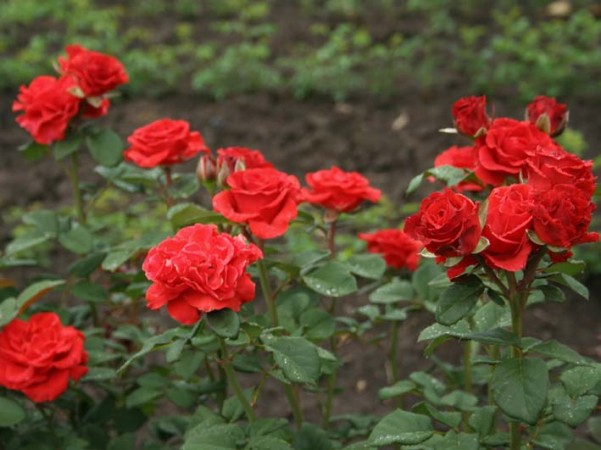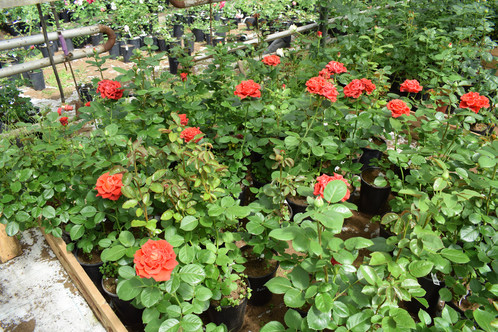We decorate the garden with roses: the subtleties of growing an elegant variety El Toro
Content
The history of the rose El Toro
Rosa El Toro is a prominent representative of the hybrid tea group. The homeland of the elegant flower is the Netherlands. The first mention of the plant dates back to 2003. The authorship is attributed to the Dutch scientist Hubert Wijnand Olij, well-known in the circle of breeders.
The name comes from the Spanish el toro, which means "bull". The flower received such an unusual comparison for the fiery red color of the petals of the buds. Other plant names are found among florists. The most common are Zeltors and Eltora. In foreign botanical reference books, El Toro may be referred to as Uncle Joe or Red Mountain Peak.

Video "Acquaintance with the Rose El Toro"
This video shows what a garden flower looks like.
Detailed characteristics of the variety
Rose El Toro is considered a favorite flower of Russian gardeners, as it is characterized by high winter hardiness. The plant is able to withstand temperatures as low as -23 ° C.
Description of the bush
The height of the ornamental bush of the hybrid tea group ranges from 60 to 80 cm. The stems are dense and erect, the thorns are practically absent. The leaves are small, carved, dark green in color with a slight reddish tint.
Description of the bud
The variety is characterized by strong and weather-resistant flower stalks. El Toro is famous for the beauty of the buds. The average bud diameter in the unopened state is 10 cm.When the flower opens, its girth can be more than 12 cm. A characteristic feature of the variety is fiery red or blood red corrugated petals. Due to the waviness of the petals, the plant looks interesting in bouquets.
One bud contains 35 to 40 petals. The outer petals can burn out when exposed to sunlight. The buds are formed singly. When in bloom, El Toro exudes a subtle scent.

Flowering features
It is characterized by abundant and long flowering. With a favorable microclimate, the first buds appear in June-July. The variety blooms until the beginning of autumn. The disadvantage is the burnout of the buds in the active sun. The fiery red color becomes less saturated. The buds may not fade completely, but in stripes or spots.
Agrotechnical features
Roses are considered the most capricious flowers, as they require special attention. Proper planting and proper care is the key to the long life of the plant.
Landing algorithm
El Toro loves abundant sunshine and no wind. For planting an ornamental culture, choose a moderately moist and well-drained soil. The optimum acidity level is from 5.6 to 7.3 pH.

When buying a seedling, carefully examine the trunk and root system. The slightest trace of rot is a sign of poor quality planting material.
The plant is planted in a pre-prepared planting pit, the depth of which should be at least 50 cm. The bottom of the pit is laid out with broken red brick or expanded clay - drainage to drain excess moisture. The soil dug out of the hole is mixed with rotted manure, peat and river sand in a ratio of 2: 3: 1: 2.
Planting is carried out at the very beginning of May, after keeping the root of the seedling in a growth biostimulator. At the end of planting, the plant is watered and mulched.
Watering and soil care rules
Caring for a rose involves abundant watering and regular loosening of the soil. Water the flowers at least once every 7 days. The day after watering, the topsoil is loosened. This procedure contributes to the enrichment of the soil with oxygen.

Root and foliar feeding
Rose El Toro responds well to both root and foliar feeding. You can fertilize a flower with organics diluted in water or with complex mineral mixtures, which are intended for flowering ornamental crops. The plant is fed 2 times per season: before flowering and at the end.
The foliar feeding option is used when the culture is damaged by harmful insects or fungal infections.
Pruning features
In the spring, while the buds have not woken up, the flower is pruned. Dead, weakened and damaged shoots are subject to removal. Do not forget to cut the young growth of the shrub.
Recommendations for preparing for wintering
Despite its high winter hardiness, the flower needs additional shelter. On the eve of winter cold weather, the trunk of the plant is sprinkled with sawdust and dry river sand. The branches can be insulated with pine spruce branches and agrofibre.
Major diseases and pests
In the description of the variety, a high level of resistance to powdery mildew and black spot is indicated. However, according to experienced gardeners, the variety has a low resistance to the diseases listed above. Fungicides Topaz, Fundazol, Ridomil Gold and Profit Gold will help protect the plant from diseases.
The main pests of the variety are spider mites, green rose aphids, rose scale insects and rose leafworms. Insecticidal preparations of systemic action "Fufanon" and "Aktara" will help to get rid of insects.
Use in landscape design and floristry
Due to its high decorative qualities, the El Toro rose fell in love with landscape designers.
The flower is often used for specimen plantings, much less often for group plantings. As the “queen of the garden,” the rose does not tolerate being close to other ornamental flowering cultures. An exception may be clematis, violets, lungwort, phlox, lilies and daisies, which favorably emphasize the grace and elegance of the main element of the flower arrangement. The flower looks interesting in combination with graceful lavender bushes, lace gypsophila paniculata and leaves of silvery wormwood.
The extraordinary beauty of the flower did not pass by the florists. The El Toro variety is often used for making bouquets, including wedding bouquets.
- Variants of using El Toro roses in floristry
Reviews of summer residents
El Toro hybrid tea rose is very popular among gardeners who willingly share their impressions of the variety.
“I have been growing hybrid tea roses for many years. During this time, favorites have appeared, including the El Toro variety. The attractive appearance of the flower compensates for the few difficulties that arise when caring for it. "
“The amazing and beautiful El Toro rose grows in my garden. Unfortunately, the plant has practically no immunity to most fungal and bacterial diseases. Needs frequent spraying with fungicides. "
When purchasing a sapling of El Toro hybrid tea rose, correctly assess your strengths and capabilities. The flower will delight with juicy and abundant flowering only with proper care.



